Correlating PSf Support Physicochemical Properties with the Formation of Piperazine-Based Polyamide and Evaluating the Resultant Nanofiltration Membrane Performance
Abstract
:1. Introduction
2. Experimental Section
2.1. Materials
2.2. Fabrication of Thin-Film Composite Membranes
2.3. Membrane Characterization
2.4. Membrane Filtration Test
3. Results and Discussion
3.1. Chemical Structure of Polysulfone Supports and Thin-Film Composite Membranes
3.2. Effect of the Polyethylene Glycol’s Molecular Weight on Nanofiltration Performance
3.2.1. Properties of Polysulfone Supports Modified Using Polyethylene Glycol of Different Molecular Weights
3.2.2. TFC Membrane Properties
3.2.3. Separation Performance Test
3.3. Mechanism
4. Conclusions
Supplementary Materials
Acknowledgments
Author Contributions
Conflicts of Interest
References
- Cadotte, J.; Forester, R.; Kim, M.; Petersen, R.; Stocker, T. Nanofiltration membranes broaden the use of membrane separation technology. Desalination 1988, 70, 77–88. [Google Scholar] [CrossRef]
- Petersen, R.J. Composite reverse osmosis and nanofiltration membranes. J. Membr. Sci. 1993, 83, 81–150. [Google Scholar] [CrossRef]
- Jeong, B.H.; Hoek, E.M.V.; Yan, Y.S.; Subramani, A.; Huang, X.F.; Hurwitz, G.; Ghosh, A.K.; Jawor, A. Interfacial polymerization of thin film nanocomposites: A new concept for reverse osmosis membranes. J. Membr. Sci. 2007, 294, 1–7. [Google Scholar] [CrossRef]
- Lee, K.P.; Arnot, T.C.; Mattia, D. A review of reverse osmosis membrane materials for desalination—Development to date and future potential. J. Membr. Sci. 2011, 370, 1–22. [Google Scholar] [CrossRef] [Green Version]
- Shakaib, M.; Ahmed, I.; Yunus, R.M.; Idris, A.; Hussain, A. Influence of monosodium glutamate additive on the morphology and permeability characteristics of polyamide dialysis membranes. J. Appl. Polym. Sci. 2013, 128, 3346–3355. [Google Scholar] [CrossRef]
- Huang, S.H.; Hsu, C.J.; Liaw, D.J.; Hu, C.C.; Lee, K.R.; Lai, J.Y. Effect of chemical structures of amines on physicochemical properties of active layers and dehydration of isopropanol through interfacially polymerized thin-film composite membranes. J. Membr. Sci. 2008, 307, 73–81. [Google Scholar] [CrossRef]
- Li, C.L.; Huang, S.H.; Liaw, D.J.; Lee, K.R.; Lai, J.Y. Interfacial polymerized thin-film composite membranes for pervaporation separation of aqueous isopropanol solution. Sep. Purif. Technol. 2008, 62, 694–701. [Google Scholar] [CrossRef]
- Huang, S.H.; Hung, W.S.; Liaw, D.J.; Lo, C.H.; Chao, W.C.; Hu, C.C.; Li, C.L.; Lee, K.R.; Lai, J.Y. Interfacially polymerized thin-film composite polyamide membranes: Effects of annealing processes on pervaporative dehydration of aqueous alcohol solutions. Sep. Purif. Technol. 2010, 72, 40–47. [Google Scholar] [CrossRef]
- Wang, Y. Pervaporation of benzene/cyclohexane mixtures through aromatic polyamide membranes. J. Membr. Sci. 2001, 185, 193–200. [Google Scholar] [CrossRef]
- Huang, S.H.; Liu, Y.Y.; Huang, Y.H.; Liao, K.S.; Hu, C.C.; Lee, K.R.; Lai, J.Y. Study on characterization and pervaporation performance of interfacially polymerized polyamide thin-film composite membranes for dehydrating tetrahydrofuran. J. Membr. Sci. 2014, 470, 411–420. [Google Scholar] [CrossRef]
- Petersen, J.; Peinemann, K.V. Novel polyamide composite membranes for gas separation prepared by interfacial polycondensation. J. Appl. Polym. Sci. 1997, 63, 1557–1563. [Google Scholar] [CrossRef]
- Sridhar, S.; Smitha, B.; Mayor, S.; Prathab, B.; Aminabhavi, T.M. Gas permeation properties of polyamide membrane prepared by interfacial polymerization. J. Mater. Sci. 2007, 42, 9392–9401. [Google Scholar] [CrossRef]
- Simcik, M.; Ruzicka, M.C.; Karaszova, M.; Sedlakova, Z.; Vejrazka, J.; Vesely, M.; Capek, P.; Friess, K.; Izak, P. Polyamide thin-film composite membranes for potential raw biogas purification: Experiments and modeling. Sep. Purif. Technol. 2016, 167, 163–173. [Google Scholar] [CrossRef]
- Koyuncu, I.; Topacik, D.; Yuksel, E. Reuse of reactive dyehouse wastewater by nanofiltration: Process water quality and economical implications. Sep. Purif. Technol. 2004, 36, 77–85. [Google Scholar] [CrossRef]
- Lin, J.Y.; Tang, C.Y.Y.; Ye, W.Y.; Sun, S.P.; Hamdan, S.H.; Volodin, A.; Van Haesendonck, C.; Sotto, A.; Luis, P.; Van der Bruggen, B. Unraveling flux behavior of superhydrophilic loose nanofiltration membranes during textile wastewater treatment. J. Membr. Sci. 2015, 493, 690–702. [Google Scholar] [CrossRef]
- Liu, T.Y.; Bian, L.X.; Yuan, H.G.; Pang, B.; Lin, Y.K.; Tong, Y.; Van der Bruggen, B.; Wang, X.L. Fabrication of a high-flux thin film composite hollow fiber nanofiltration membrane for wastewater treatment. J. Membr. Sci. 2015, 478, 25–36. [Google Scholar] [CrossRef]
- Ghaee, A.; Shariaty-Niassar, M.; Barzin, J.; Matsuura, T.; Ismail, A.F. Preparation of chitosan/cellulose acetate composite nanofiltration membrane for wastewater treatment. Desalin. Water Treat. 2016, 57, 14453–14460. [Google Scholar] [CrossRef]
- Lin, J.; Ye, W.; Baltaru, M.-C.; Tang, Y.P.; Bernstein, N.J.; Gao, P.; Balta, S.; Vlad, M.; Volodin, A.; Sotto, A. Tight ultrafiltration membranes for enhanced separation of dyes and na 2 so 4 during textile wastewater treatment. J. Membr. Sci. 2016, 514, 217–228. [Google Scholar] [CrossRef]
- Sanches, S.; Fraga, M.; Silva, N.; Nunes, P.; Crespo, J.; Pereira, V. Pilot scale nanofiltration treatment of olive mill wastewater: A technical and economical evaluation. Environ. Sci. Pollut. Res. 2017, 24, 3506–3518. [Google Scholar] [CrossRef] [PubMed]
- Xu, Y.C.; Wang, Z.X.; Cheng, X.Q.; Xiao, Y.C.; Shao, L. Positively charged nanofiltration membranes via economically mussel-substance-simulated co-deposition for textile wastewater treatment. Chem. Eng. J. 2016, 303, 555–564. [Google Scholar] [CrossRef]
- Chen, Z.W.; Luo, J.Q.; Chen, X.R.; Hang, X.F.; Shen, F.; Wan, Y.H. Fully recycling dairy wastewater by an integrated isoelectric precipitation-nanofiltration-anaerobic fermentation process. Chem. Eng. J. 2016, 283, 476–485. [Google Scholar] [CrossRef]
- Salgado, C.M.; Fernández-Fernández, E.; Palacio, L.; Carmona, F.J.; Hernández, A.; Prádanos, P. Application of pervaporation and nanofiltration membrane processes for the elaboration of full flavored low alcohol white wines. Food Bioprod. Process. 2017, 101, 11–21. [Google Scholar] [CrossRef]
- Chandrapala, J.; Duke, M.C.; Gray, S.R.; Weeks, M.; Palmer, M.; Vasiljevic, T. Nanofiltration and nanodiafiltration of acid whey as a function of ph and temperature. Sep. Purif. Technol. 2016, 160, 18–27. [Google Scholar] [CrossRef]
- Conidi, C.; Cassano, A. Recovery of phenolic compounds from bergamot juice by nanofiltration membranes. Desalin. Water Treat. 2015, 56, 3510–3518. [Google Scholar] [CrossRef]
- Ong, Y.K.; Li, F.Y.; Sun, S.P.; Zhao, B.W.; Liang, C.Z.; Chung, T.S. Nanofiltration hollow fiber membranes for textile wastewater treatment: Lab-scale and pilot-scale studies. Chem. Eng. Sci. 2014, 114, 51–57. [Google Scholar] [CrossRef]
- Chen, Q.; Yang, Y.; Zhou, M.S.; Liu, M.H.; Yu, S.C.; Gao, C.J. Comparative study on the treatment of raw and biologically treated textile effluents through submerged nanofiltration. J. Hazard. Mater. 2015, 284, 121–129. [Google Scholar] [CrossRef] [PubMed]
- Farhadian, M.; Askari, N.; Razmjou, A. Decolorization of ionic dyes from synthesized textile wastewater by nanofiltration using response surface methodology. Adv. Environ. Sci. 2015, 1, 85–92. [Google Scholar]
- Mullett, M.; Fornarelli, R.; Ralph, D. Nanofiltration of mine water: Impact of feed ph and membrane charge on resource recovery and water discharge. Membranes 2014, 4, 163–180. [Google Scholar] [CrossRef] [PubMed]
- Visser, T.; Modise, S.; Krieg, H.; Keizer, K. The removal of acid sulphate pollution by nanofiltration. Desalination 2001, 140, 79–86. [Google Scholar] [CrossRef]
- Hayrynen, K.; Pongracz, E.; Vaisanen, V.; Pap, N.; Manttari, M.; Langwaldt, J.; Keiski, R.L. Concentration of ammonium and nitrate from mine water by reverse osmosis and nanofiltration. Desalination 2009, 240, 280–289. [Google Scholar] [CrossRef]
- Wei, L.; Liang, L. Treatment of mining wastewater by nanofiltration. J. Beijing Univ. Chem. Technol. 2011, 1, 006. [Google Scholar]
- Le Gouellec, Y.A.; Elimelech, M. Calcium sulfate (gypsum) scaling in nanofiltration of agricultural drainage water. J. Membr. Sci. 2002, 205, 279–291. [Google Scholar] [CrossRef]
- Wang, J.; Wang, L.; Miao, R.; Lv, Y.; Wang, X.; Meng, X.; Yang, R.; Zhang, X. Enhanced gypsum scaling by organic fouling layer on nanofiltration membrane: Characteristics and mechanisms. Water Res. 2016, 91, 203–213. [Google Scholar] [CrossRef] [PubMed]
- Kharaka, Y.K.; Ambats, G.; Presser, T.S.; Davis, R.A. Removal of selenium from contaminated agricultural drainage water by nanofiltration membranes. Appl. Geochem. 1996, 11, 797–802. [Google Scholar] [CrossRef]
- Nghiem, L.D.; Schafer, A.I.; Elimelech, M. Pharmaceutical retention mechanisms by nanofiltration membranes. Environ. Sci. Technol. 2005, 39, 7698–7705. [Google Scholar] [CrossRef] [PubMed]
- Sheth, J.P.; Qin, Y.J.; Sirkar, K.K.; Baltzis, B.C. Nanofiltration-based diafiltration process for solvent exchange in pharmaceutical manufacturing. J. Membr. Sci. 2003, 211, 251–261. [Google Scholar] [CrossRef]
- Javier Benitez, F.; Acero, J.L.; Real, F.J.; Roldán, G.; Rodriguez, E. Ultrafiltration and nanofiltration membranes applied to the removal of the pharmaceuticals amoxicillin, naproxen, metoprolol and phenacetin from water. J. Chem. Technol. Biotechnol. 2011, 86, 858–866. [Google Scholar] [CrossRef]
- Paul, M.; Jons, S.D. Chemistry and fabrication of polymeric nanofiltration membranes: A review. Polymer 2016, 103, 417–456. [Google Scholar] [CrossRef]
- Raaijmakers, M.J.; Benes, N.E. Current trends in interfacial polymerization chemistry. Prog. Polym. Sci. 2016, 63, 86–142. [Google Scholar] [CrossRef]
- Ahmad, A.; Ooi, B. Properties–performance of thin film composites membrane: Study on trimesoyl chloride content and polymerization time. J. Membr. Sci. 2005, 255, 67–77. [Google Scholar] [CrossRef]
- Jegal, J.; Min, S.G.; Lee, K.H. Factors affecting the interfacial polymerization of polyamide active layers for the formation of polyamide composite membranes. J. Appl. Polym. Sci. 2002, 86, 2781–2787. [Google Scholar] [CrossRef]
- Mansourpanah, Y.; Madaeni, S.S.; Rahimpour, A. Fabrication and development of interfacial polymerized thin-film composite nanofiltration membrane using different surfactants in organic phase; study of morphology and performance. J. Membr. Sci. 2009, 343, 219–228. [Google Scholar] [CrossRef]
- Saha, N.K.; Joshi, S.V. Performance evaluation of thin film composite polyamide nanofiltration membrane with variation in monomer type. J. Membr. Sci. 2009, 342, 60–69. [Google Scholar] [CrossRef]
- Tang, Y.J.; Wang, L.J.; Xu, Z.L.; Wei, Y.M.; Yang, H. Novel high-flux thin film composite nanofiltration membranes fabricated by the naclo pre-oxidation of the mixed diamine monomers of pip and bhttm in the aqueous phase solution. J. Membr. Sci. 2016, 502, 106–115. [Google Scholar] [CrossRef]
- Wijmans, J.; Kant, J.; Mulder, M.; Smolders, C. Phase separation phenomena in solutions of polysulfone in mixtures of a solvent and a nonsolvent: Relationship with membrane formation. Polymer 1985, 26, 1539–1545. [Google Scholar] [CrossRef]
- Tsai, H.; Li, L.; Lee, K.; Wang, Y.; Li, C.; Huang, J.; Lai, J. Effect of surfactant addition on the morphology and pervaporation performance of asymmetric polysulfone membranes. J. Membr. Sci. 2000, 176, 97–103. [Google Scholar] [CrossRef]
- Soroko, I.; Lopes, M.P.; Livingston, A. The effect of membrane formation parameters on performance of polyimide membranes for organic solvent nanofiltration (osn): Part A. Effect of polymer/solvent/non-solvent system choice. J. Membr. Sci. 2011, 381, 152–162. [Google Scholar] [CrossRef]
- Ghosh, A.K.; Hoek, E.M.V. Impacts of support membrane structure and chemistry on polyamide–polysulfone interfacial composite membranes. J. Membr. Sci. 2009, 336, 140–148. [Google Scholar] [CrossRef]
- Singh, P.S.; Joshi, S.V.; Trivedi, J.J.; Devmurari, C.V.; Rao, A.P.; Ghosh, P.K. Probing the structural variations of thin film composite ro membranes obtained by coating polyamide over polysulfone membranes of different pore dimensions. J. Membr. Sci. 2006, 278, 19–25. [Google Scholar] [CrossRef]
- Oh, N.W.; Jegal, J.; Lee, K.H. Preparation and characterization of nanofiltration composite membranes using polyacrylonitrile (pan). II. Preparation and characterization of polyamide composite membranes. J. Appl. Polym. Sci. 2001, 80, 2729–2736. [Google Scholar] [CrossRef]
- Misdan, N.; Lau, W.J.; Ismail, A.F.; Matsuura, T. Formation of thin film composite nanofiltration membrane: Effect of polysulfone substrate characteristics. Desalination 2013, 329, 9–18. [Google Scholar] [CrossRef]
- Misdan, N.; Lau, W.J.; Ismail, A.F.; Matsuura, T.; Rana, D. Study on the thin film composite poly(piperazine-amide) nanofiltration membrane: Impacts of physicochemical properties of substrate on interfacial polymerization formation. Desalination 2014, 344, 198–205. [Google Scholar] [CrossRef]
- Ang, M.B.M.Y.; Ji, Y.-L.; Huang, S.-H.; Tsai, H.-A.; Hung, W.-S.; Hu, C.-C.; Lee, K.-R.; Lai, J.-Y. Incorporation of carboxylic monoamines into thin-film composite polyamide membranes to enhance nanofiltration performance. J. Membr. Sci. 2017, 539, 52–64. [Google Scholar] [CrossRef]
- Corbett, J.C.W.; McNeil-Watson, F.; Jack, R.O.; Howarth, M. Measuring surface zeta potential using phase analysis light scattering in a simple dip cell arrangement. Colloid Surf. A 2012, 396, 169–176. [Google Scholar] [CrossRef]
- Zheng, Q.-Z.; Wang, P.; Yang, Y.-N.; Cui, D.-J. The relationship between porosity and kinetics parameter of membrane formation in PSf ultrafiltration membrane. J. Membr. Sci. 2006, 286, 7–11. [Google Scholar] [CrossRef]
- Zheng, Q.-Z.; Wang, P.; Yang, Y.-N. Rheological and thermodynamic variation in polysulfone solution by peg introduction and its effect on kinetics of membrane formation via phase-inversion process. J. Membr. Sci. 2006, 279, 230–237. [Google Scholar] [CrossRef]
- Kim, J.-H.; Lee, K.-H. Effect of peg additive on membrane formation by phase inversion. J. Membr. Sci. 1998, 138, 153–163. [Google Scholar] [CrossRef]
- Chakrabarty, B.; Ghoshal, A.K.; Purkait, M.K. Sem analysis and gas permeability test to characterize polysulfone membrane prepared with polyethylene glycol as additive. J. Colloid Interface Sci. 2008, 320, 245–253. [Google Scholar] [CrossRef] [PubMed]
- Ma, Y.X.; Shi, F.M.; Ma, J.; Wu, M.N.; Zhang, J.; Gao, C.J. Effect of peg additive on the morphology and performance of polysulfone ultrafiltration membranes. Desalination 2011, 272, 51–58. [Google Scholar] [CrossRef]
- Schrader, B. Infrared and Raman Spectroscopy: Methods and Applications; John Wiley & Sons: New York, NY, USA, 2008. [Google Scholar]
- An, Q.F.; Li, F.; Ji, Y.L.; Chen, H.L. Influence of polyvinyl alcohol on the surface morphology, separation and anti-fouling performance of the composite polyamide nanofiltration membranes. J. Membr. Sci. 2011, 367, 158–165. [Google Scholar] [CrossRef]
- Kwak, S.Y.; Jung, S.G.; Yoon, Y.S.; Ihm, D.W. Details of surface features in aromatic polyamide reverse osmosis membranes characterized by scanning electron and atomic force microscopy. J. Polym. Sci. Part B Polym. Phys. 1999, 37, 1429–1440. [Google Scholar] [CrossRef]
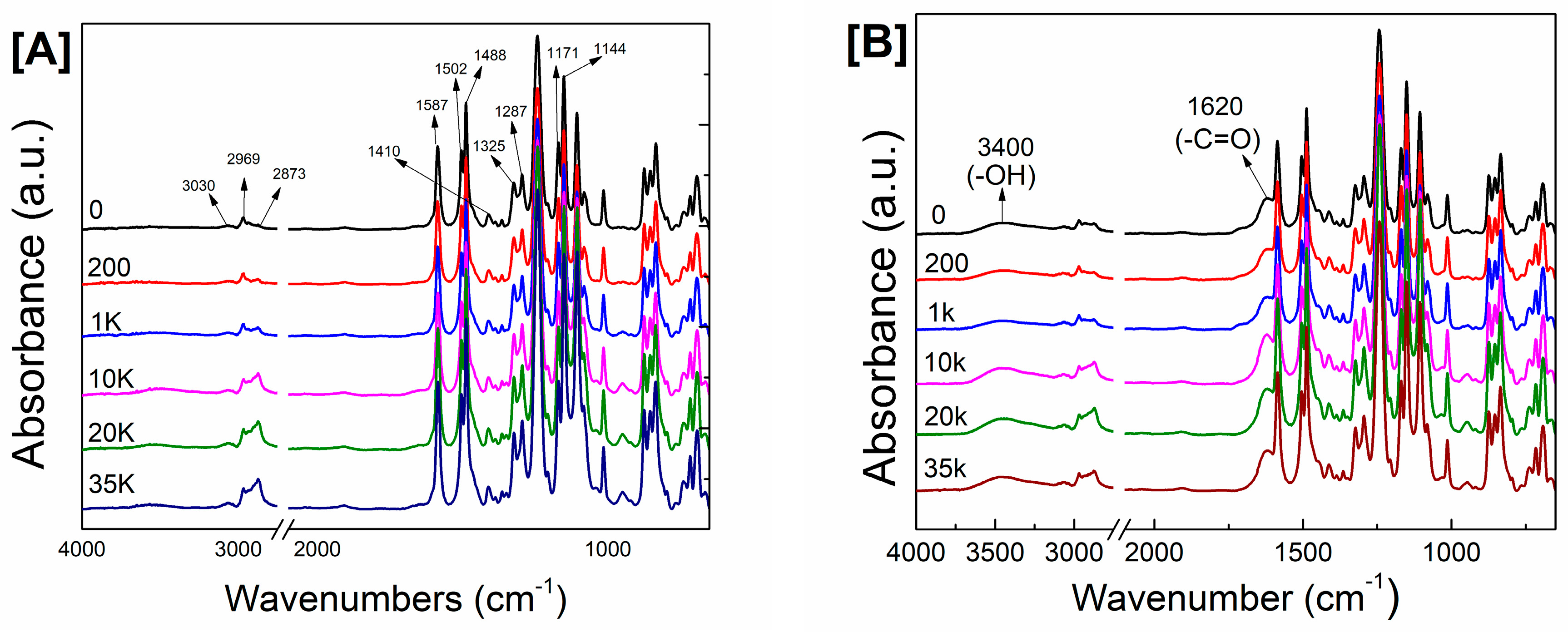


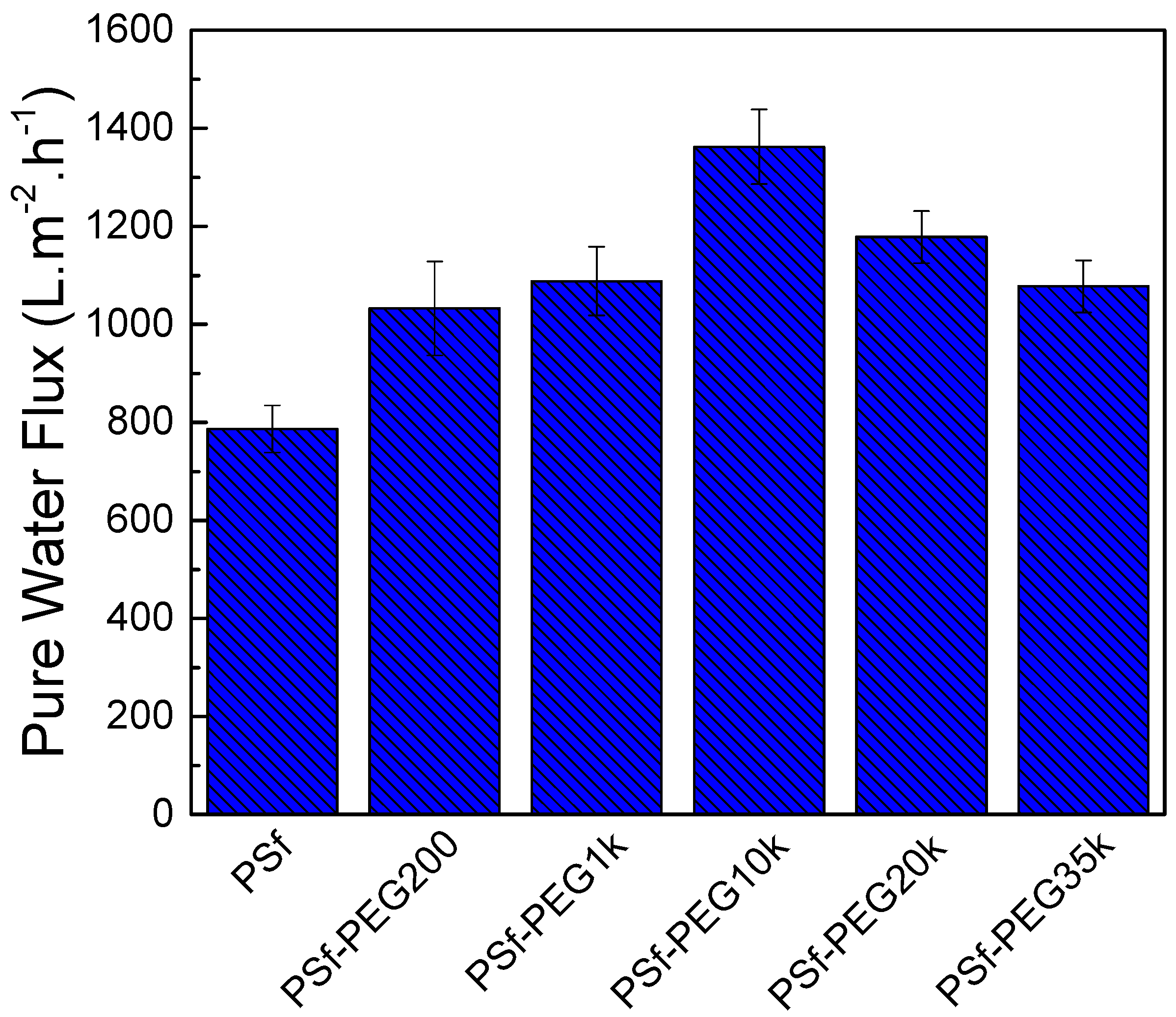
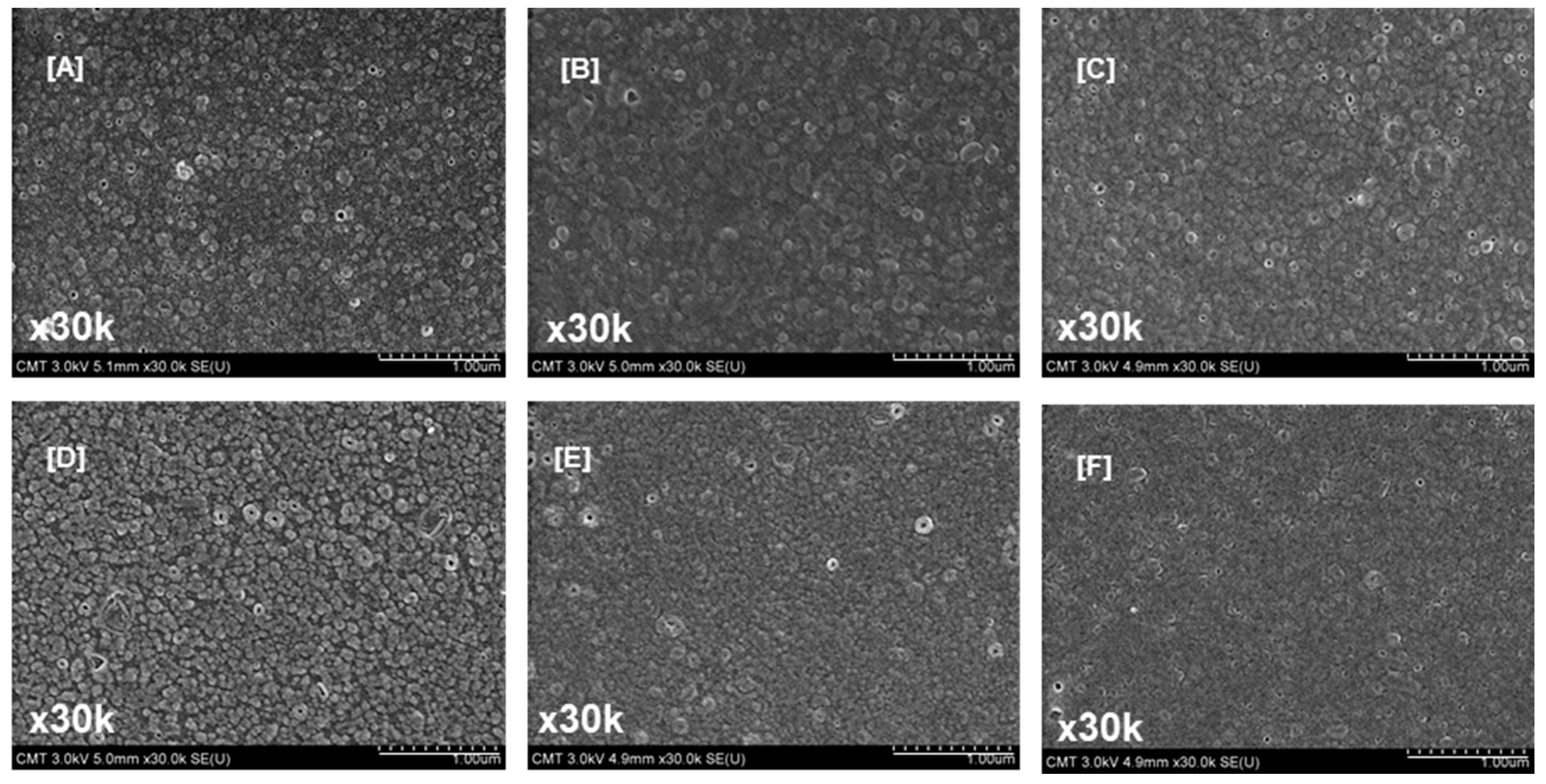
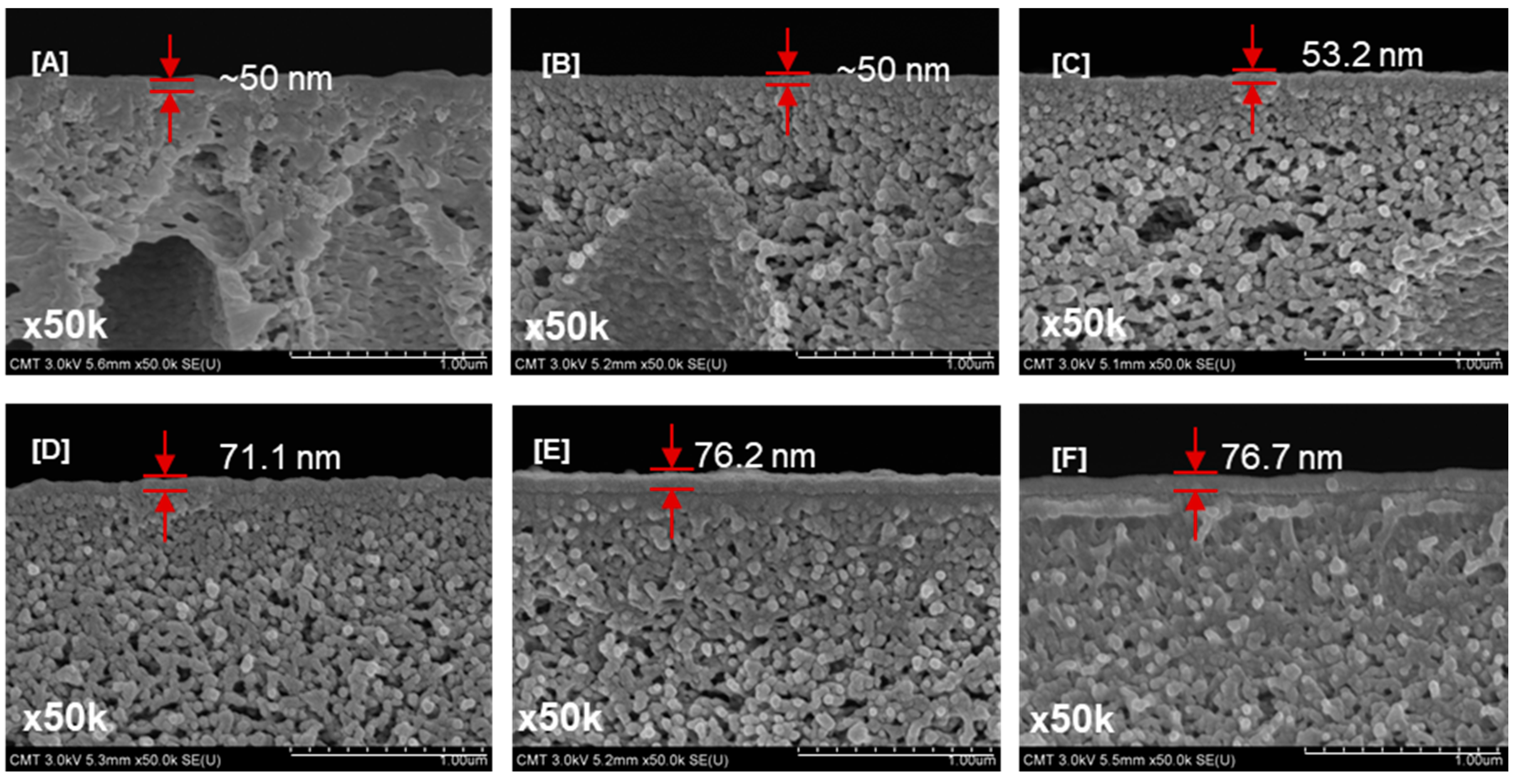
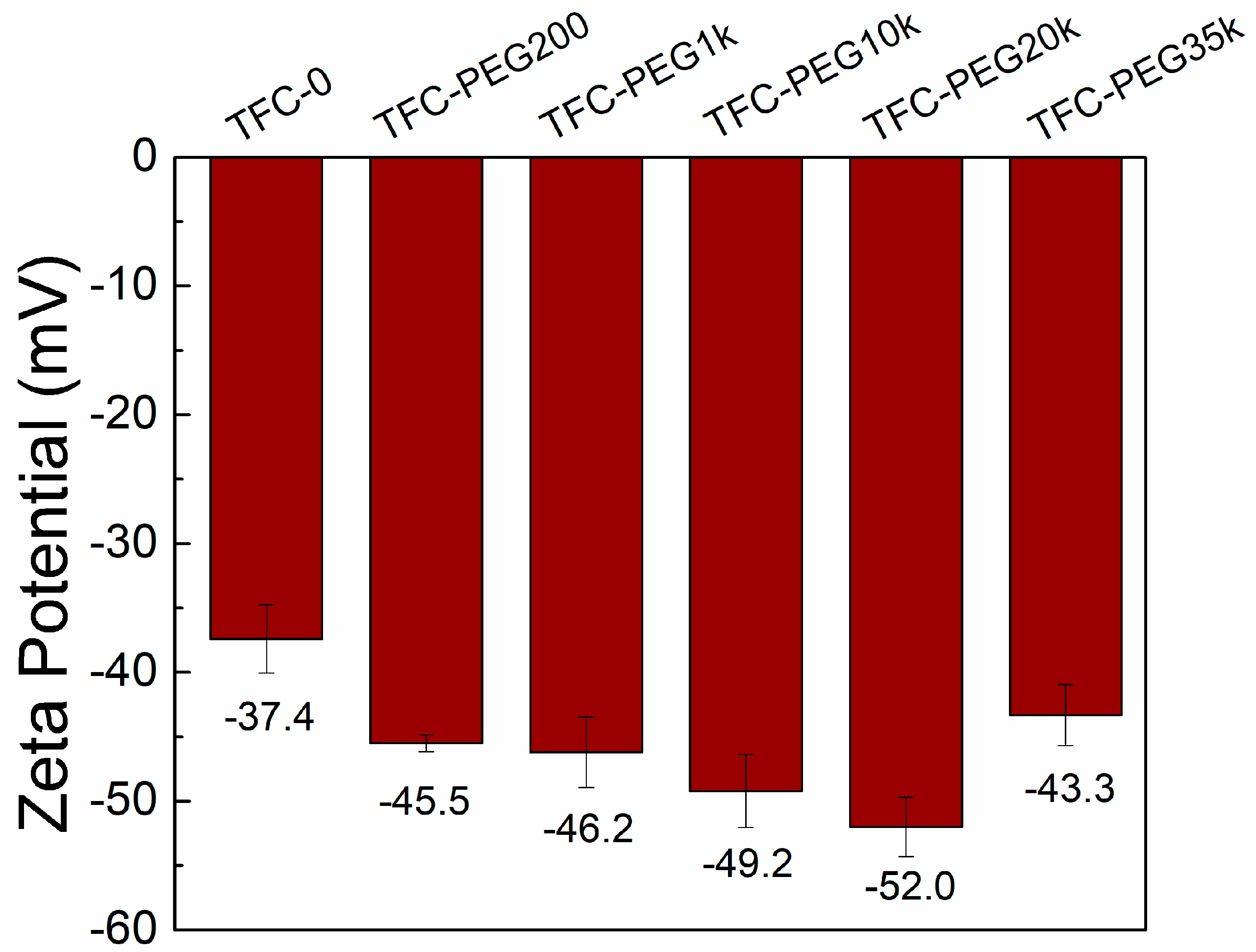
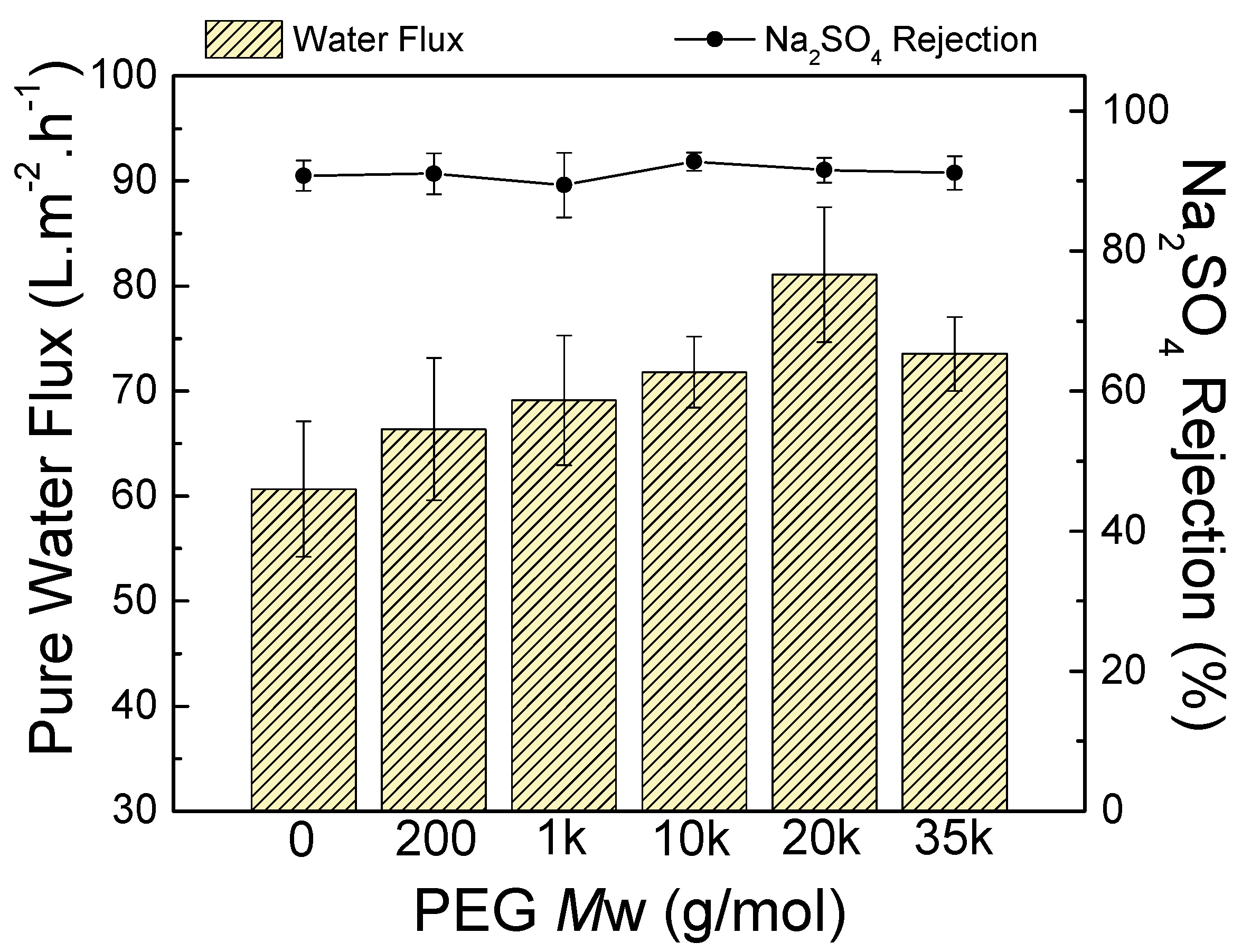
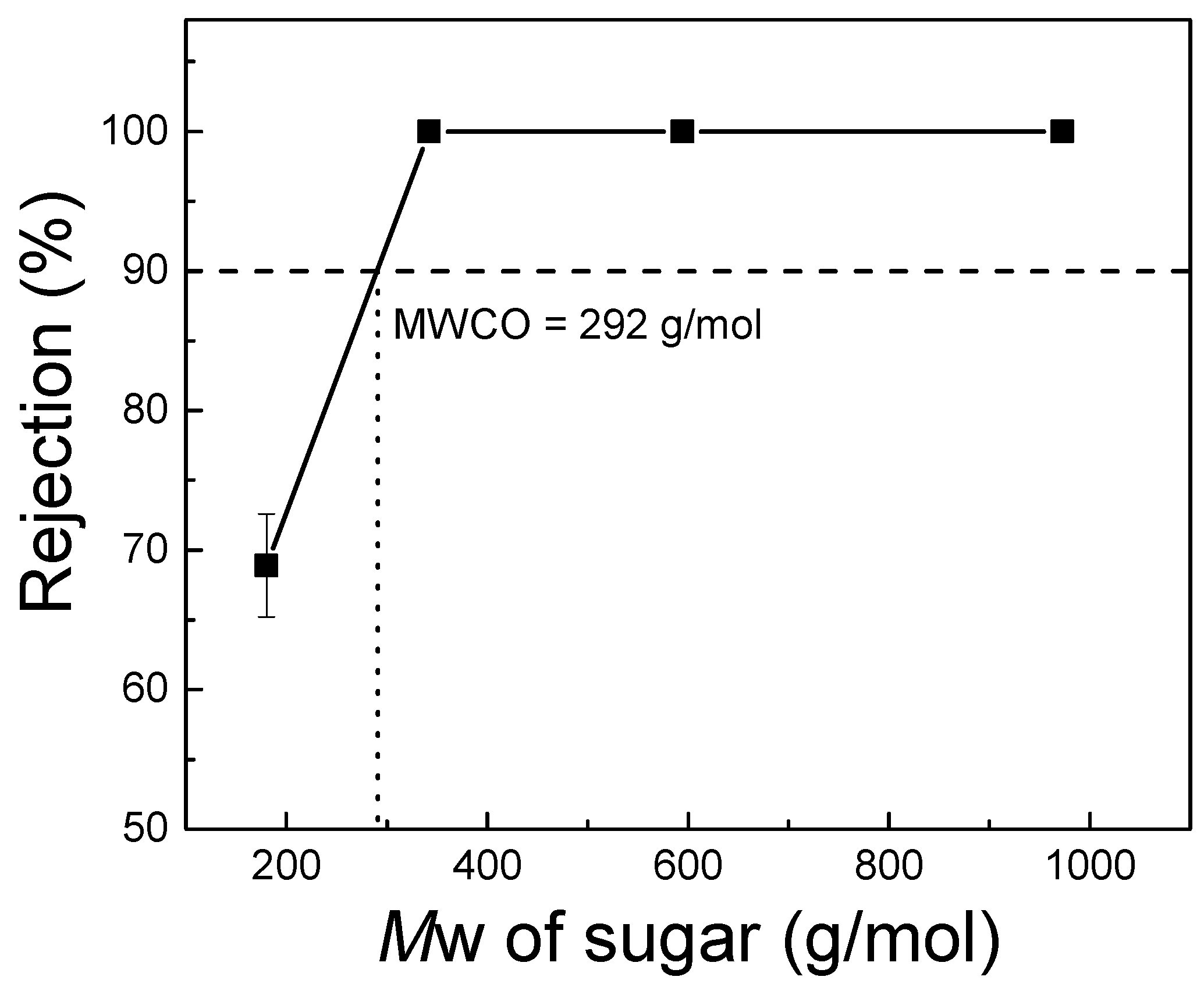
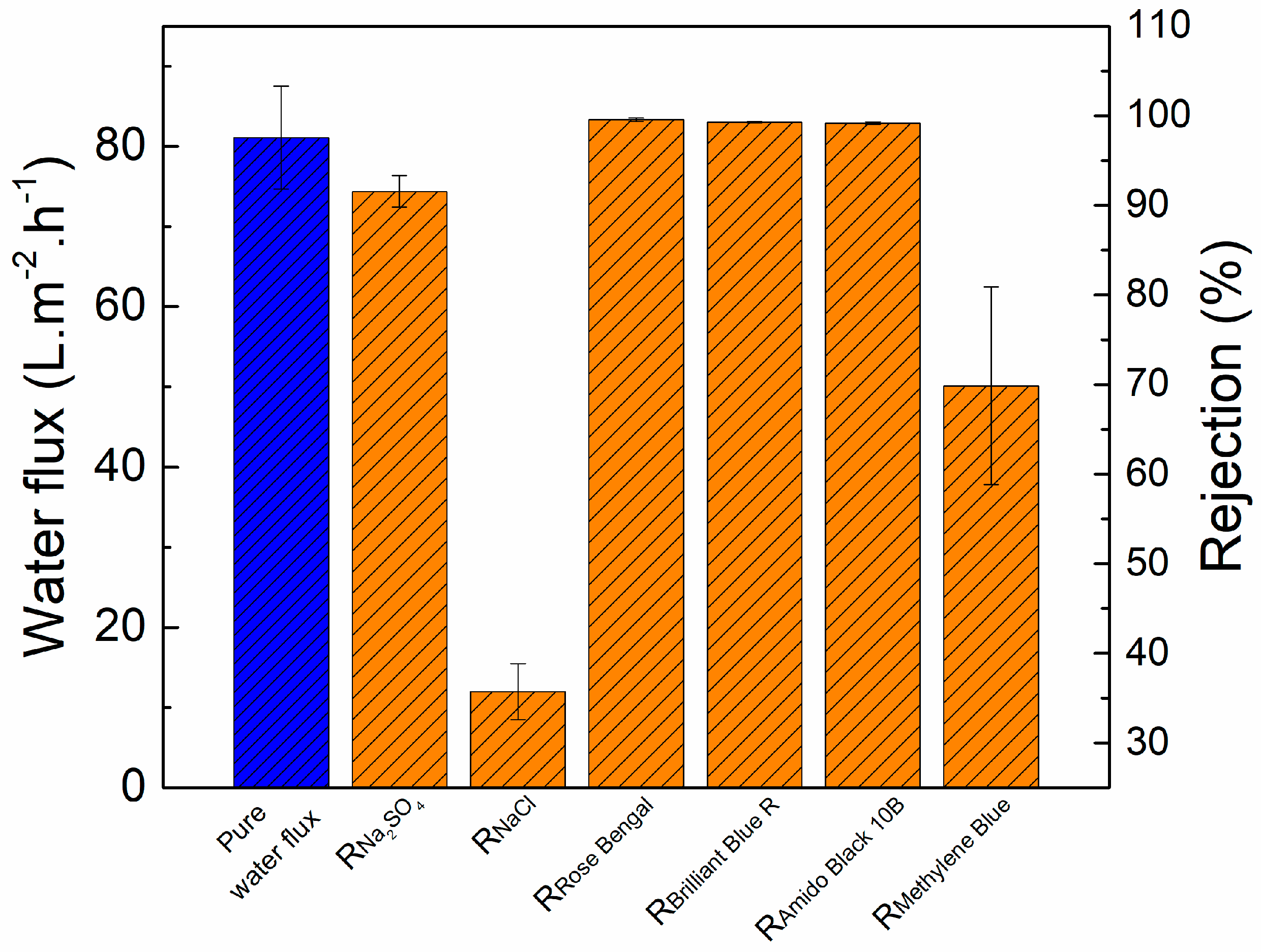
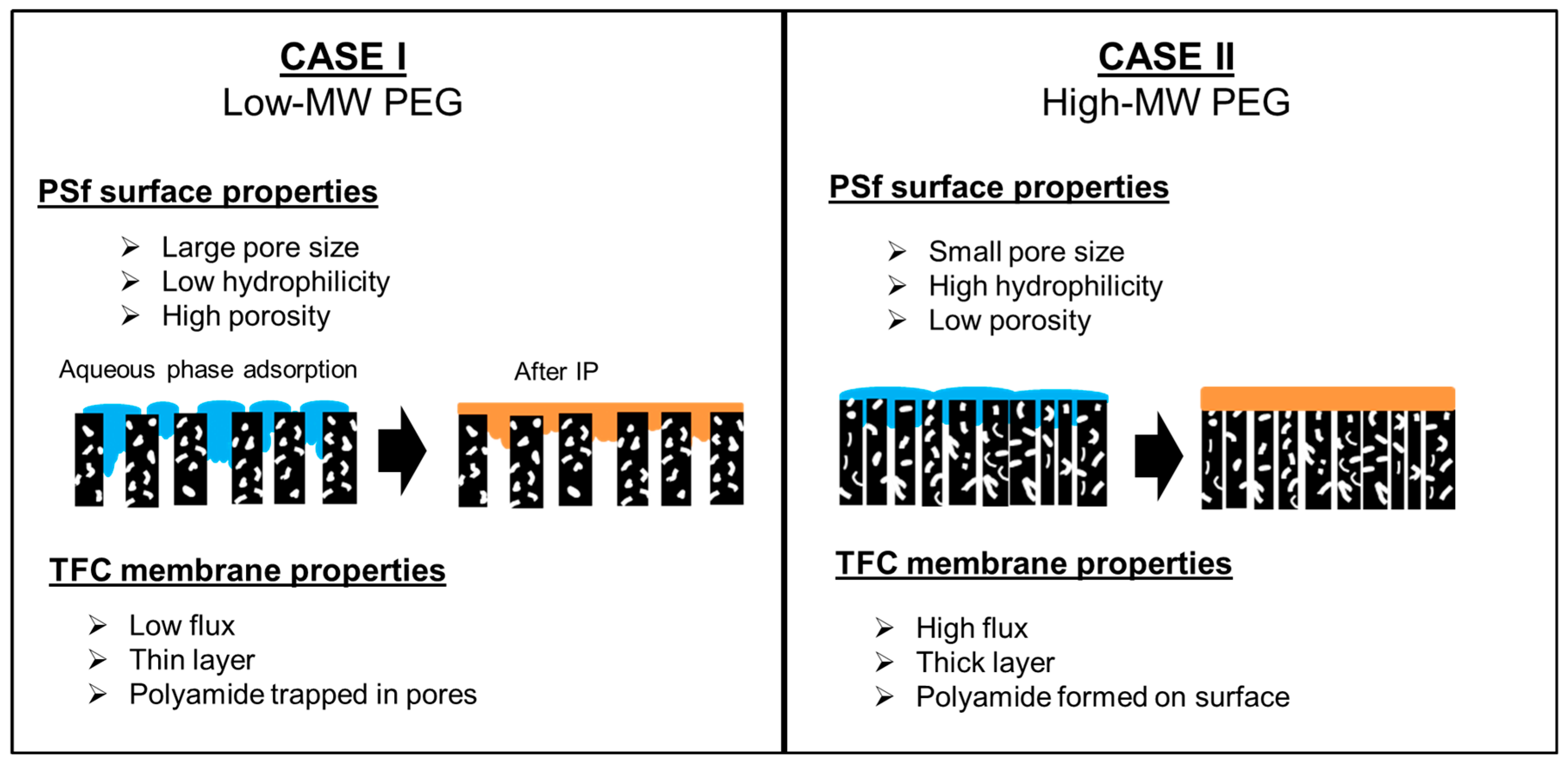
| Membrane | Solution Composition (wt %) | PEG MW (g/mol) | Viscosity (mPa·s) | ||||
|---|---|---|---|---|---|---|---|
| PSf | NMP | PEG a | |||||
| PSf | 16 | 84 | - | - | 555 | ± | 9 |
| PSf-PEG200 | 16 | 84 | 50 | 200 | 552 | ± | 7 |
| PSf-PEG1k | 16 | 84 | 50 | 1000 | 592 | ± | 8 |
| PSf-PEG10k | 16 | 84 | 50 | 10,000 | 850 | ± | 13 |
| PSf-PEG20k | 16 | 84 | 50 | 20,000 | 1106 | ± | 15 |
| PSf-PEG35k | 16 | 84 | 50 | 35,000 | 1546 | ± | 21 |
| Membrane | Surface Porosity a (%) | Surface Pore Size a (nm) | ||||
|---|---|---|---|---|---|---|
| PSf | 17.3 | ± | 0.7 | 16.6 | ± | 2.7 |
| PSf–PEG200 | 14.5 | ± | 0.9 | 12.2 | ± | 2.3 |
| PSf–PEG1k | 11.2 | ± | 0.8 | 10.8 | ± | 3.4 |
| PSf–PEG10k | 10.9 | ± | 1.0 | 10.4 | ± | 2.7 |
| PSf–PEG20k | 9.5 | ± | 1.1 | 10.3 | ± | 3.0 |
| PSf–PEG35k | 8.6 | ± | 1.0 | 11.9 | ± | 2.4 |
| Membrane | Water Contact Angle (°) | Surface Roughness, Rq (nm) | ||||
|---|---|---|---|---|---|---|
| PSf | 83.7 | ± | 0.3 | 6.6 | ± | 0.6 |
| PSf–PEG200 | 73.1 | ± | 0.4 | 6.6 | ± | 0.2 |
| PSf–PEG1k | 69.1 | ± | 0.6 | 6.5 | ± | 0.3 |
| PSf–PEG10k | 60.0 | ± | 0.5 | 4.6 | ± | 0.1 |
| PSf–PEG20k | 55.5 | ± | 0.3 | 4.2 | ± | 0.2 |
| PSf–PEG35k | 51.0 | ± | 0.5 | 4.1 | ± | 0.2 |
| Membrane | Water Contact Angle (°) | Surface Roughness, Rq (nm) | ||||
|---|---|---|---|---|---|---|
| TFC–0 | 36.1 | ± | 1.2 | 8.0 | ± | 0.1 |
| TFC–PEG200 | 38.3 | ± | 0.7 | 11.6 | ± | 1.0 |
| TFC–PEG1k | 29.6 | ± | 0.9 | 10.2 | ± | 1.4 |
| TFC–PEG10k | 25.5 | ± | 0.8 | 7.8 | ± | 0.6 |
| TFC–PEG20k | 21.5 | ± | 0.6 | 6.9 | ± | 0.8 |
| TFC–PEG35k | 16.9 | ± | 1.0 | 6.9 | ± | 0.5 |
© 2017 by the authors. Licensee MDPI, Basel, Switzerland. This article is an open access article distributed under the terms and conditions of the Creative Commons Attribution (CC BY) license (http://creativecommons.org/licenses/by/4.0/).
Share and Cite
Ang, M.B.M.Y.; Lau, V.J.; Ji, Y.-L.; Huang, S.-H.; An, Q.-F.; Caparanga, A.R.; Tsai, H.-A.; Hung, W.-S.; Hu, C.-C.; Lee, K.-R.; et al. Correlating PSf Support Physicochemical Properties with the Formation of Piperazine-Based Polyamide and Evaluating the Resultant Nanofiltration Membrane Performance. Polymers 2017, 9, 505. https://doi.org/10.3390/polym9100505
Ang MBMY, Lau VJ, Ji Y-L, Huang S-H, An Q-F, Caparanga AR, Tsai H-A, Hung W-S, Hu C-C, Lee K-R, et al. Correlating PSf Support Physicochemical Properties with the Formation of Piperazine-Based Polyamide and Evaluating the Resultant Nanofiltration Membrane Performance. Polymers. 2017; 9(10):505. https://doi.org/10.3390/polym9100505
Chicago/Turabian StyleAng, Micah Belle Marie Yap, Victor Jr. Lau, Yan-Li Ji, Shu-Hsien Huang, Quan-Fu An, Alvin R. Caparanga, Hui-An Tsai, Wei-Song Hung, Chien-Chieh Hu, Kueir-Rarn Lee, and et al. 2017. "Correlating PSf Support Physicochemical Properties with the Formation of Piperazine-Based Polyamide and Evaluating the Resultant Nanofiltration Membrane Performance" Polymers 9, no. 10: 505. https://doi.org/10.3390/polym9100505







